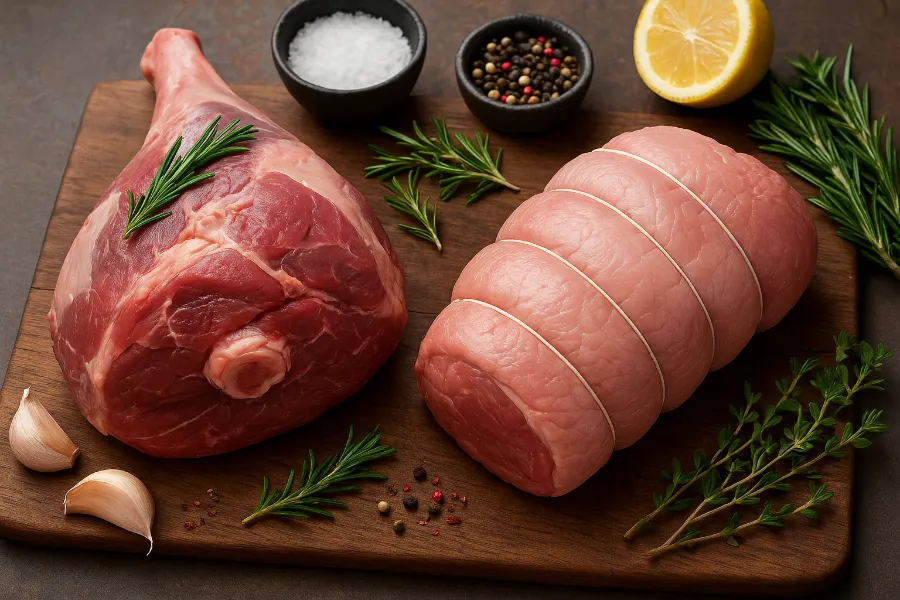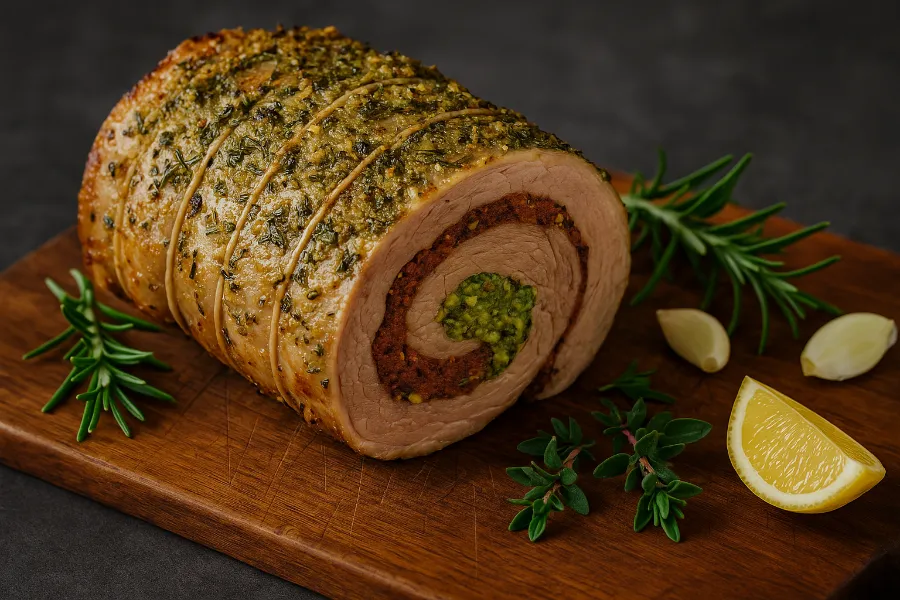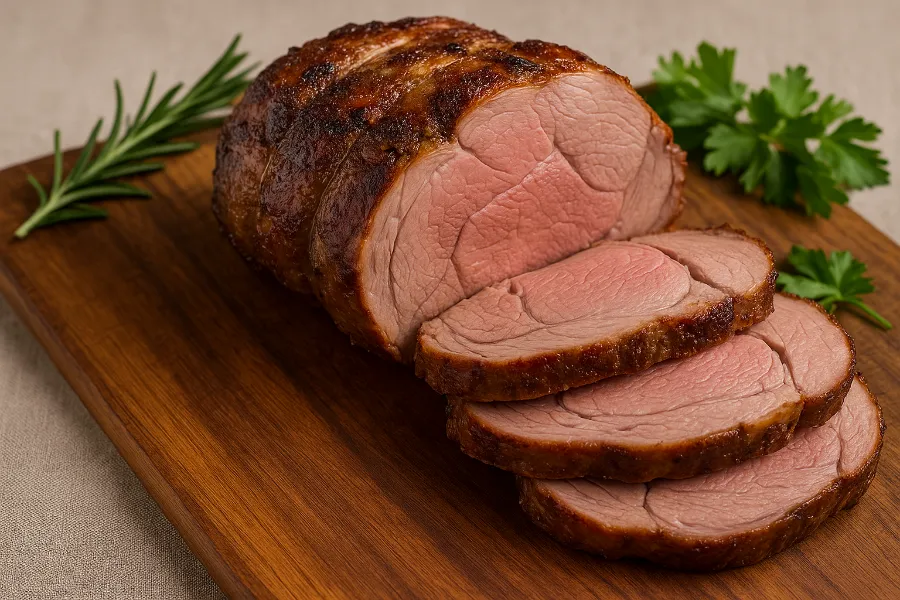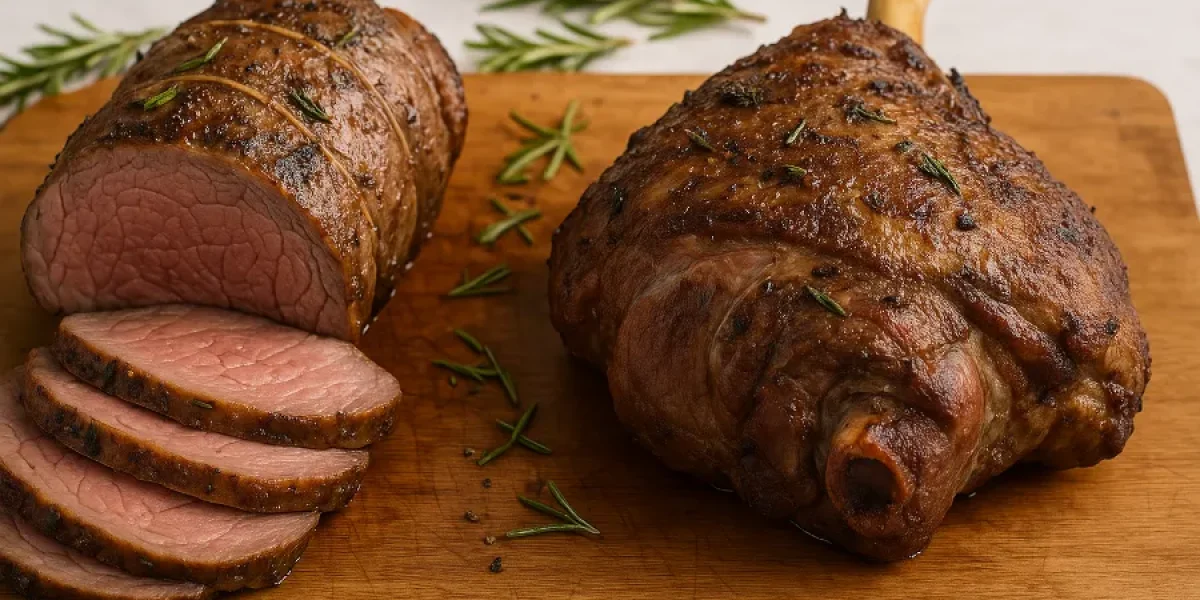If you’re reading this, you’ve probably found yourself standing at the meat counter or scrolling online, wondering which version of the roasted lamb leg to buy. I’ve been there too — staring at the butcher’s display, trying to decide between a boneless leg and a bone-in one. It seems like a small choice, but it actually changes everything: flavor, ease of cooking, carving, and the final wow-factor when you bring it to the table.
In this post, I’ll walk you through what I’ve learned about the difference between boneless and bone-in lamb roast, share which option might fit you best (especially if you’re a home cook), talk about how amateurs and pros handle it differently, and unpack the advantages and disadvantages of each.

Boneless Lamb Roast
Let’s start with the boneless version — because this is often the one that feels most approachable.
What It Is
A boneless lamb roast means the bone has been removed. Usually the butcher will butterfly the leg, roll it, and tie it neatly with butcher’s twine, creating a compact, even shape that cooks consistently. Because it’s uniform, you can count on even results every time — and it fits more easily into smaller roasting pans.
Why You Might Pick It (Advantages)
- Easier for beginners — the even shape makes roasting predictable.
- Carving is effortless; no bones to navigate or awkward angles to fight with.
- Perfect for anyone following a boneless leg of lamb roast recipe where precision matters.
- You can stuff, roll, or season it inside and out for maximum flavor.
- Great for family dinners or when you want neat, restaurant-style slices.
What to Keep in Mind (Disadvantages)
- Without the bone, you lose a little of that “roast house” depth of flavor.
- It can cost slightly more per pound, since the butcher has done the trimming.
- It cooks faster — a benefit for some, but it means you must keep an eye on timing.
My Experience
When I roast boneless, I usually roll the leg with crushed garlic, rosemary, thyme, and lemon zest. Because it’s so evenly shaped, it cooks beautifully and slices like butter. If I’m hosting and want minimal carving drama, boneless is my go-to.
Roasted Lamb Leg

Now let’s talk about the centerpiece itself — the roasted lamb leg, in all its glory.
Why It’s Special
A roasted lamb leg, whether bone-in or boneless, always feels like a celebration. The aroma of herbs and garlic fills the kitchen, the crust turns golden, and the anticipation builds as everyone waits for that first slice. For special occasions — birthdays, holidays, or even just a Sunday meal worth remembering — nothing beats it.
Keys to Success
The secret is patience. Roast at the right temperature, rest your lamb properly, and don’t rush the carving. Whether boneless or bone-in, the real magic happens in those last few steps — when you let the meat relax and the juices redistribute.
Boneless Leg of Lamb Roast Recipe
Here’s a straightforward approach that works every single time:
- Start with a butterflied or pre-rolled boneless leg of lamb.
- Rub with olive oil, salt, pepper, minced garlic, chopped rosemary, and lemon zest.
- Roll it tightly and tie it with butcher’s twine.
- Let it rest at room temperature for 30 minutes while the oven preheats.
- Roast at 400°F (200°C) for 15 minutes to develop a crust, then lower to 350°F (175°C) and roast until the internal temperature hits 135°F (57°C) for medium-rare.
- Rest for 20 minutes before slicing.
This version gives you control and consistency — no surprises, no uneven cooking. And because you can season inside and out, every slice tastes infused with herbs and citrus.
Roast Lamb for Easter Dinner
When I think of roast lamb for Easter dinner, I think of family, tradition, and that sense of occasion that comes with serving a centerpiece meal.
Why It’s Perfect for Easter
- It’s symbolic and seasonal — lamb naturally belongs to spring.
- It feeds a crowd and still leaves leftovers.
- It pairs beautifully with Easter’s favorite sides: minted peas, roasted potatoes, and lemony asparagus.
My Take
If I’m hosting a large Easter meal, I sometimes choose bone-in for that old-world presentation. But if I’m juggling multiple dishes, a boneless lamb roast saves time and keeps me calm. It’s easier to carve and serve, especially when guests hover around the kitchen asking, “When’s dinner ready?”
Difference Between Boneless and Bone-In Lamb Roast
Here’s where the real comparison begins.
Bone-In
- The bone acts as a heat conductor, which helps distribute warmth through the meat and can enhance juiciness.
- Many people believe the bone adds flavor, lending subtle richness and depth.
- The irregular shape means cooking times vary across the roast — the outer edge may be medium-rare while the center near the bone stays pinker.
- Carving requires more attention but looks incredibly impressive on the table.
Boneless
- The shape is even, so it cooks consistently.
- It’s easier to season thoroughly, especially if you butterfly it open before rolling.
- Slicing is clean and simple — no bones, no mess.
- It’s versatile — you can grill it, roast it, or even cook it sous vide if you’re feeling adventurous.
Summary
Both have strengths:
- Choose bone-in when you want tradition, theater, and a deep, savory flavor.
- Choose boneless when you value convenience, precision, and simple serving.
Best Options: Home Cook vs Pro

For the Home Cook
If you’re just getting into roasting, go boneless. It’s straightforward, easier to manage, and nearly foolproof if you use a thermometer. The flavor is wonderful, and the even cooking helps you build confidence.
For the Pro
If you’ve been around the roasting block and enjoy culinary challenges, bone-in is pure satisfaction. You’ll manage the temperature zones, master the carving, and get that classic roast feel. For many chefs, bone-in is the only “real” roast — but I say both have their place.
My Honest Take
I use both depending on my mood. For a weeknight dinner with friends? Boneless. For a Sunday roast when I want to flex my carving knife skills? Bone-in all the way.
Advantages and Disadvantages
Bone-In Advantages
- Deep, rich flavor and traditional presentation
- Juicier near the bone
- Ideal for slow roasting and holidays
Bone-In Disadvantages
- Carving can be tricky
- Uneven doneness if rushed
- Larger and slower to cook
Boneless Advantages
- Even cooking and fast roasting
- Easier to carve and serve
- Perfect for stuffing and rolling
Boneless Disadvantages
- Slightly less “roasty” flavor
- More expensive per pound
- Cooks faster — easier to overdo
Final Thoughts: Which Should You Choose?
So, should you go boneless or bone-in for your next roasted lamb leg?
Ask yourself:
- How comfortable are you in the kitchen?
- Do you want presentation or simplicity?
- How much time do you have?
- Is this an everyday dinner or a special occasion?
If you’re new to roasting lamb, start boneless. It’s easy, manageable, and still full of flavor. Once you’re confident, try a bone-in roasted lamb leg — the reward is a dramatic, aromatic centerpiece that feels straight out of a restaurant kitchen.
At the end of the day, it’s not about which one is “better.” It’s about which one makes you feel good about cooking and proud of what you serve. The best lamb roast is the one that brings people together around your table — juicy, golden, and shared with laughter.
FAQs
A boneless roasted lamb leg has the bone removed, cooks more evenly, and is easier to carve. A bone-in version delivers deeper flavor and that classic, show-stopping presentation.
For home cooks and beginners, boneless is best. It’s easier to handle, cooks faster, and gives you consistent results without worrying about carving around bones.
Many cooks say yes—the bone adds depth and juiciness as it heats and releases subtle flavors. However, with good seasoning, boneless lamb can taste equally delicious.
A boneless leg takes about 15–18 minutes per pound, while bone-in can take around 20 minutes per pound. Always check doneness with a meat thermometer for perfect results.
For medium-rare, aim for 135°F (57°C). Always rest your lamb for 15–20 minutes after roasting to keep it juicy and tender.
Usually, yes. Boneless cuts cost more per pound because the butcher does extra prep work, though every bit is edible and easy to portion.
If you want an elegant, easy-to-serve meal, go boneless. If you love a dramatic centerpiece and richer flavor, choose bone-in—it’s a holiday classic for a reason.













